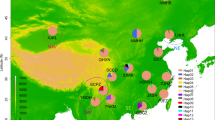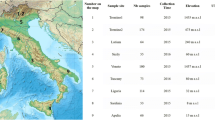Abstract
Forty-seven microsatellite loci were amplified in Drosophila melanogaster, Drosophila simulans, Drosophila mauritiana and Drosophila sechellia. The two cosmopolitan species D. melanogaster and D. simulans were found to be the most variable ones, followed by D. mauritiana and D. sechellia. A model based clustering algorithm was applied to the population samples of D. melanogaster, D. simulans and D. sechellia. No evidence for population substructure was detected within species-most likely due to insufficient power. A Markov chain Monte Carlo method developed for demographic inference based on microsatellites provided unambiguous evidence for population contraction in D. melanogaster, D. simulans and D. sechellia, despite that the D. melanogaster and D. simulans population samples were of non-African origin and represented recently expanded populations.
Similar content being viewed by others
References
Adams, M.D., S.E. Celniker, R.A. Holt, et al., 2000. The genome sequence of Drosophila melanogaster. Science 287: 2185–2195.
Agis, M. & C. Schlötterer, 2001. Microsatellite variation in natural Drosophila melanogaster populations from New South Wales (Australia) and Tasmania. Mol. Ecol. 10: 1197–1205.
Andolfatto, P., 2001. Contrasting Patterns of X-Linked and Autosomal Nucleotide Variation in Drosophila melanogaster and Drosophila simulans. Mol. Biol. Evol. 18: 279–290.
Bachtrog, D., M. Agis, M. Imhof & C. Schlötterer, 2000. Microsatellite variability differs between dinucleotide repeat motifs-evidence from Drosophila melanogaster. Mol. Biol. Evol. 17: 1277–1285.
Beaumont, M.A., 1999. Detecting population expansion and decline using microsatellites. Genetics 153: 2013–2029.
Colson, I. & D.B. Goldstein, 1999. Evidence for complex mutations at microsatellite loci in Drosophila. Genetics 152: 617–627.
Dieringer, D. & C. Schlötterer, 2003. Microsatellite analyzer (MSA)-a platform independent analysis tool for large microsatellite data sets. Molecular Ecology Notes 3: 167–169.
Ellegren, H., C.R. Primmer & B.C. Sheldon, 1995. Microsatellite 'evolution': directionality or bias? Nat. Genet. 11: 360–362.
Felsenstein, J., 1991. PHYLIP, Version 3.57c, University of Washington, Seattle.
Goldstein, D. & C. Schlötterer, 1999. Microsatellites: Evolution and Applications. Oxford University Press, Oxford.
González, A.M., V.M. Cabrera, J.M. Larruga & A. Gullón, 1982. Genetic distance in the sibling species Drosophila melanogaster, Drosophila simulans and Drosophila mauritiana. Evolution 36: 517–522.
Harpending, H.C., M.A. Batzer, M. Gurven, L.B. Jorde, A.R. Rogers & S.T. Sherry, 1998. Genetic traces of ancient demography. Proc. Natl. Acad. Sci. USA 95: 1961–1967.
Harr, B. & C. Schlötterer, 2000. Long microsatellite alleles in Drosophila melanogaster have a downward mutation bias and short persistence times, which cause their genome-wide underrepresentation. Genetics 155: 1213–1220.
Harr, B., S. Weiss, J.R. David, G. Brem & C. Schlötterer, 1998. A microsatellite-based multilocus phylogeny of the Drosophila melanogaster species complex. Curr. Biol. 8: 1183–1186.
Hey, J. & R.M. Kliman, 1993. Population genetics and phylogenetics of DNA sequence variation at multiple loci within the Drosophila melanogaster species complex. Mol. Biol. Evol. 10: 804–822.
Hutter, C.M., M.D. Schug & C.F. Aquadro, 1998. Microsatellite variation in Drosophila melanogaster and Drosophila simulans: a reciprocal test of the ascertainment bias hypothesis. Mol. Biol. Evol. 15: 1620–1636.
Irvin, S.D., K.A. Wetterstrand, C.M. Hutter & C.F. Aquadro, 1998. Genetic variation and differentiation at microsatellite loci in Drosophila simulans: evidence for founder effects in new world populations. Genetics 150: 777–790.
Kauer, M., B. Zangerl, D. Dieringer & C. Schlötterer, 2002. Chromosomal patterns of microsatellite variability contrast sharply in African and non-African populations of Drosophila melanogaster. Genetics 160: 247–256.
Kliman, R.M., P. Andolfatto, J.A. Coyne, F. Depaulis, M. Kreitman, A.J. Berry, J. McCarter, J. Wakeley & J. Hey, 2000. The population genetics of the origin and divergence of the Drosophila simulans complex species. Genetics 156: 1913–1931.
Lachaise, D., M.-L. Cariou, J.R. David, F. Lemeunier, L. Tsacas & M. Ashburner, 1988. Historical biogeography of the Drosophila melanogaster species subgroup. Evol. Biol. 22: 159–225.
Miller, S.A., D.D. Dykes & H.F. Polesky, 1988. A simple salting out procedure for extracting DNA from human nucleated cells. Nucl. Acids Res. 16: 1215.
Minch, E., A. Ruiz-Linares, D. Goldstein, M. Feldman & L.L. Cavalli-Sforza, 1995. Microsat (version 1.4d): a computer program for calculating various statistics on microsatellite allele data.
Moriyama, E.N. & J.R. Powell, 1996. Intraspecific nuclear DNA variation in Drosophila. Mol. Biol. Evol. 13: 261–277.
Page, R.D.M., 1996. TREEVIEW: an application to display phylogenetic trees on personal computers. Comput. Appl. Biosci. 12: 357–358.
Pritchard, J.K., M. Stephens & P. Donnelly, 2000. Inference of population structure using multilocus genotype data. Genetics 155: 945–959.
Saitou, R.K. & M. Nei, 1987. The neighbor-joining method: a new method for reconstructing phylogenetic trees. Mol. Biol. Evol. 4: 406–425.
Schlötterer, C., 2000. Evolutionary dynamics of microsatellite DNA. Chromosoma 109: 365–371.
Schlötterer, C. & J. Pemberton, 1998. The use of microsatellites for genetic analysis of natural populations-a critical review, pp. 71–86 in Molecular Approaches to Ecology and Evolution, edited by R. DeSalle & B. Schierwater. Birkhäuser, Basel.
Schlötterer, C. & B. Zangerl, 1999. The use of imperfect microsatellites for DNA fingerprinting and population genetics, pp. 153–165 in DNA Profiling and DNA Fingerprinting, edited by J.T. Epplen & T. Lubjuhn. Birkhäuser, Basel.
Schlötterer, C., C. Vogl & D. Tautz, 1997. Polymorphism and locus-specific effects on polymorphism at microsatellite loci in natural Drosophila melanogaster populations. Genetics 146: 309–320.
Schlötterer, C., R. Ritter, B. Harr & G. Brem, 1998. High mutation rates of a long microsatellite allele in Drosophila melanogaster provides evidence for allele-specific mutation rates. Mol. Biol. Evol. 15: 1269–1274.
Author information
Authors and Affiliations
Rights and permissions
About this article
Cite this article
Harr, B., Schlötterer, C. Patterns of Microsatellite Variability in the Drosophila Melanogaster Complex. Genetica 120, 71–77 (2004). https://doi.org/10.1023/B:GENE.0000017631.00820.49
Issue Date:
DOI: https://doi.org/10.1023/B:GENE.0000017631.00820.49




